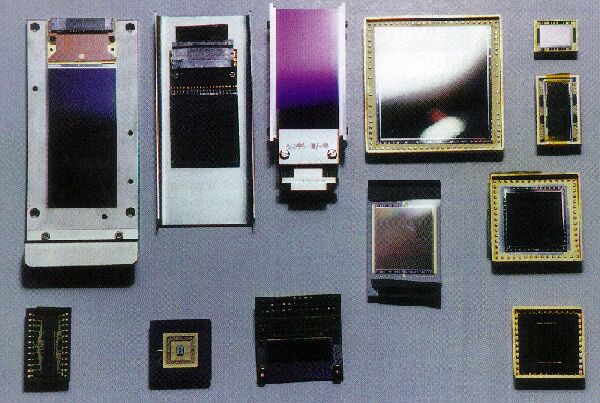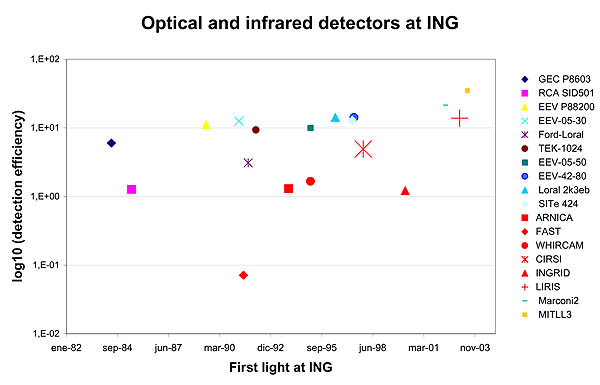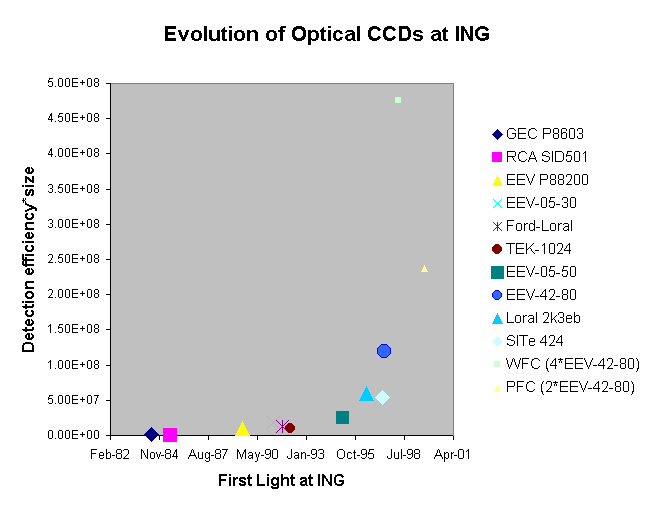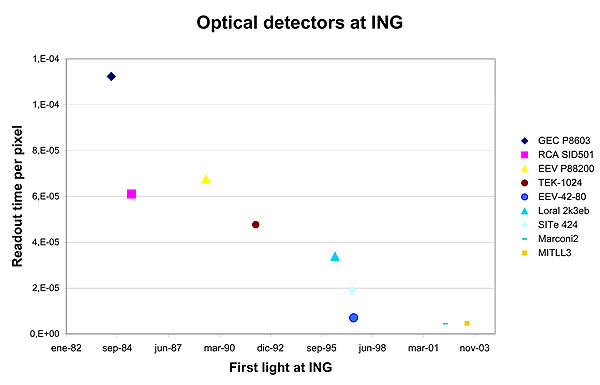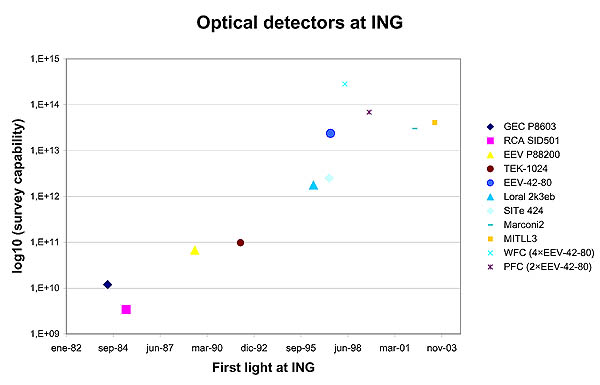| Chip Type
| Name
| Operating Dates
| Bias Level (ADU)
| Read Noise (e-)
| Gain (e-/ADU)
| Max Counts -in most cases linearity limit
(ADU)
| Format (useful imaging area) (pixels)
| Pixel Size (microns)
| Dark Current (e/-hour)
| Description
| Comments
|
| RCA 501EX |
RCA |
Jul 85-Feb 87 |
1300 |
60 |
3.8 |
>65k |
320×512 |
30µ |
|
Thinned Anti-Reflecting (AR) CCD, enhanced
peak/UV response, uncoated. Back-illuminated. |
|
| RCA 501EX |
RCA2 |
Feb 87- |
300 |
60 |
3.8 |
>65k |
320×512 |
30µ |
|
Thinned AR CCD, enhanced peak/UV response,
uncoated. Back-illuminated. |
|
| GEC P8603 |
FOS1 |
May 85-May 88 |
150 |
7 |
1 |
27k |
385×578 |
22µ |
|
|
|
| GEC P8603 |
FOS1 |
May 88- |
150 |
8 |
1 |
>65k |
385×578 |
22µ |
|
Dye-coating CCD to give enhanced UV-response |
High-quality coated-CCD |
| GEC P8603 |
GEC1 |
Jun 84-Dec 86 |
140 |
5 |
0.8 |
40k |
385×578 |
22µ |
|
|
A nominal preflash was routinely used |
| GEC P8603 |
GEC1 |
Feb 87-Dec 87 |
100 |
7 |
0.8 |
>30k |
385×578 |
22µ |
|
Un-coated chip |
|
| GEC P8603 |
GEC3 |
Dec 87-Apr 92 |
100 |
7 |
1 |
>65k |
385×578 |
22µ |
|
Dye-coating CCD to give enhanced UV-response |
|
| GEC P8603 |
GEC2 |
Sep 85-Mar 86 |
100 |
6 |
1 |
30k |
385×578 |
22µ |
|
|
|
| GEC P8607 |
GEC2 |
Jul 86-Nov 86 |
100 |
8 |
1.6 |
35k |
385×578 |
16µ |
|
|
|
| GEC P8603 |
GEC2 |
Nov 86-Jan 88 |
150 |
9 |
2.2 |
>65k |
385×578 |
22µ |
|
|
|
| GEC P8603 |
GEC4 |
Jan 88-May 89 |
200 |
6.5 |
1.1 |
>65k |
385×578 |
22µ |
|
Dye-coating CCD to give enhanced UV-response |
|
| GEC P8603 |
FOS2 |
Aug 87-May 89 |
200 |
10 |
2 |
30k |
385×578 |
22µ |
|
Dye-coating CCD to give enhanced UV-response |
Standard ESO-coated EEV CCD |
| GEC P8603 |
GEC5 |
Jul 88- |
150 |
9 |
1.1 |
40k |
385×578 |
22µ |
|
Dye-coating CCD to give enhanced UV-response |
Standard ESO-coated EEV CCD |
| GEC P8603 |
GEC6 |
May 89-May 92 |
200 |
8 |
1 |
60k |
385×578 |
22µ |
|
Dye-coating CCD to give enhanced UV-response |
|
| GEC P8603 |
FOS2 |
May 89- |
200 |
9.5 |
2.3 |
>50k |
385×578 |
22µ |
|
Dye-coating CCD to give enhanced UV-response |
|
| EEV P88225 |
EEV1 |
Jul 89-Dec 89 |
2450 |
5 |
1.7 |
60k |
770×1152 |
22.5µ |
|
|
In July 89 switched to operate with the
new WHT Dwingeloo CCD controller |
| EEV P88231 |
EEV2 |
Dec 89-Jun 91 |
2630 |
4 |
1.1 |
60k |
770×1152 |
22.5µ |
|
Super-grade, un-coated 88200 CCD |
|
| EEV-05-30 |
EEV3 |
Apr 91- Aug 98 |
3850 |
3.5 |
0.8 |
60k |
1242×1152 |
22.5µ |
|
Metachrome phosphor coating, for UV
response |
|
| EEV-05-20 |
EEV4 |
Jun 91- |
2700 |
4 |
1 |
50k |
770×1152 |
22.5µ |
|
Metachrome phosphor coating, for UV
response |
Coated, super-grade chip |
| EEV-05-30 |
EEV5 |
Oct 91- |
4100 |
4.5 |
0.7 |
>45k |
1242×1152 |
22.5µ |
8 |
Metachrome phosphor coating, for UV
response |
Coated, super-grade chip. |
| EEV-05-30 |
EEV6 |
Oct 91- |
3600 |
3.5 |
1.0 |
>50k |
1242×1152 |
22.5µ |
|
Metachrome phosphor coating, for UV
response |
|
| Tek TK1024 |
TEK1 |
Mar 92-Oct 92 |
450 |
5/12 |
2.4 |
>60k |
1024×1024 |
24µ |
|
Thinned AR CCD for enhanced peak/UV response |
|
| Tek TK1024 |
TEK1 |
Nov 92- |
2290 |
5 |
1.3 |
60k |
1024×1024 |
24µ |
|
Thinned AR CCD for enhanced peak/UV response |
|
| EEV-05-30 |
EEV7 |
Apr 92- |
4300 |
4 |
0.76 |
>60k |
1242×1152 |
22.5µ |
|
Metachrome phosphor coating, for UV
response |
|
| EEV-02-06 |
GEC7 |
May 92- |
7600 |
8.5 |
1.4 |
>60k |
335×520 |
22µ |
|
Metachrome phosphor coating, for UV
response |
|
| GEC P8603 |
GEC3.1 |
May 92- |
100 |
7 |
1 |
>65k |
385×578 |
22µ |
|
Dye-coating CCD to give enhanced UV-response |
|
| Ford-Loral |
Ford |
|
|
|
|
|
2048×2048 |
15µ |
|
| |
| Tek TK1024 |
TEK2 |
Nov 93- |
1088 |
4.9 |
1.1 |
60k |
1024×1024 |
24µ |
|
Thinned AR CCD for enhanced peak/UV response | |
| Tek TK1024 |
TEK3 |
May 94-Dec 98 |
800 |
4.5 |
0.7 |
>65k |
1024×1024 |
24µ |
9 |
Thinned AR CCD for enhanced peak/UV response |
|
| Tek TK1024 |
TEK4 |
Jul 94- |
1138 |
4.0 |
1.2 |
60k |
1024×1024 |
24µ |
<6 |
Thinned AR CCD for enhanced peak/UV response |
|
| EEV-05-50 |
EEV9 |
Feb 95-Aug 98 |
4390 |
4.4 |
0.69 |
50k |
2186×1152 |
22.5µ |
|
Metachrome phosphor coating, for UV
response |
|
| EEV-42-80 |
EEV10 |
Jul 97-Mar 98 |
|
7.5 |
0.75 |
|
2048×4096 |
13.5µ |
~0 |
|
|
| Loral |
LOR1a |
Jun 97-Jan 98 |
2486 |
6.4 |
0.63 |
60k |
2048×2048 |
15µ |
11 |
|
|
| Loral |
LOR2 |
Jun 97-Jan 98 |
|
|
|
|
2048×2048 |
15µ |
|
|
|
| EEV-42-80 |
EEV12 |
May 98- |
930 |
4.5 |
1.0 |
|
2048×4100 |
13.5µ |
5.1 |
|
|
| SITe |
SITe1 |
May 97- |
1240 |
6.1 |
1.35 |
|
2048×2048 |
24µ |
3 |
|
|
Tek
TK 1024 |
TEK6 |
Mar 95- |
1001 |
5.7 |
1.35 |
60k |
1024×1024 |
24µ |
|
Thinned AR CCD |
|
Tek
TK 1024 |
TEK5 |
Dec 94- |
427 |
4.3 |
1.1 |
60k |
1024×1024 |
24µ |
7 |
|
|
| EEV-42-80 |
EEV10a |
Mar 98- |
794 |
4.2 |
1.2 |
65k |
2048×1024 |
24µ |
4 |
|
|
| FOS1 |
FOS1 |
Mar 98- |
1147 |
8.6 |
0.8 |
60k |
512×1024 |
15µ |
1 |
Thinned backside illuminated with passivated platinum surface |
|
| SITe |
SITe2 |
Dec 97- |
906 |
6.6 |
1.1 |
60k |
2048×2048 |
24µ |
1 |
|
|
| EEV-42-80 |
WHTWFC |
November 1999- |
1463(fast)-1371(slow) |
|
1.3(fast)-0.9(slow) |
60K |
2048×4100 |
13.5µ |
|
The camera contains two EEV-42-80 thinned and AR coated CCDs butted along their long axis to provide a 4K × 4K pixel mosaic. |
It's used in both PFIP and WYFFOS |
| EEV-42-80 |
EEV13 |
July 2001- |
2250(slow)-1750(fast) |
4 (slow)-6.7(fast) |
1.2(slow)-2.4(fast) |
|
2048×4100 |
13.5µ |
|
|
|
| Marconi |
Marconi2 |
May 2002- |
726 (fast)-1386 (slow) |
5.0 (fast)-3.5 (slow) |
2.2 (fast)-1.1 (slow) |
62k (fast)-57k (slow) |
2047×4611 |
13.5µ |
3e- per hour |
Grade 1 Deep Depletion low fringing CCD with 550nm AR coating.
|
Red sensitive device assigned to ISIS red arm on the WHT.
|
| MIT CC1D20 |
MITLL3 |
2003- |
3450 (fast)-6451 (slow) |
2.8 (fast)-2.3 (slow) |
1.37 (fast)-0.67 (slow) |
60k (fast)-65k (slow) |
2043×4098 |
15µ |
Unknown |
CC1D20 deep depletion.
|
Assigned to OASIS on the WHT.
|
| CCD 4720 |
AG 1-4 (autoguiders/TV) |
March 2003- |
1715 (fast)-1880 (slow) |
7.0 (fast)-4.4 (slow) |
1.0 (fast)-0.5 (slow) |
47k (fast)- 65k (slow) |
1028×977 |
13µ |
<1e-/s |
Thinned backside-illuminated chip with hermetically sealed packages and integral Peltier coolers.
|
|
| CCD 5710 |
AG 5-7 (autoguiders/TV) |
December 2003- |
1620 (fast)-2040 (slow) |
11.0 (fast)-7.0 (slow) |
1.80 (fast)-0.83 (slow) |
47k (fast)- 65k (slow) |
512×512 |
13µ |
<1e-/s |
Thinned backside-illuminated chip with hermetically sealed packages and integral Peltier coolers.
|
|
| E2V CCD97 |
QUCAM1 |
May 2005- |
2300(fast)-2320(slow) |
0.1(fast)-1 (slow) |
0.01(fast)-0.125(slow) |
18K |
1026×1024 |
13µ |
<1e-/hour |
|
|
| E2V CCD201-20-4-122 |
QUCAM2 |
May 2005- |
2400(fast)-2200(slow) |
<1(fast)-4 (slow) |
1(fast)-0.97(slow) |
|
1026×1024 |
13µ |
<1e-/hour |
|
|
CCD44-82-5-D23 |
RED+ |
November 2006- |
3190 (slow)-2320(fast) |
~3.9 (slow)-~6.2(fast) |
0.98(slow)-1.9(fast) |
60K |
2048×4096 |
15µ |
<8e-/hour |
|
|
CCD44-82-1-D23 |
AUXCAM |
November 2007- |
1900(slow)-1020(fast) |
~3.2(slow)-~5.6(fast) |
0.92(slow)-1.86(fast) |
65K |
2048×4096 |
15µ |
<4e-/hour |
|
|
| E2V CCD201-20-4-122 |
QUCAM3 |
September 2008- |
2400 (fast)-1980 (slow) |
<1(fast)-4(slow) |
260 (fast)-1 (slow) |
|
1026×1024 |
13µ |
<1e-/hour |
|
|
CCD44-82-1-D23 |
RED+2 |
February 2011- |
3730(slow)-2980(fast) |
3.5(slow)-5.7(fast) |
0.9(slow)-1.9(fast) |
60K |
2048×4096 |
15µ |
<8e-/hour |
|
|
| Chip Type
|
Name
|
Operating Dates
|
Bias Level (ADU)
|
Read Noise (e-)
|
Gain (e-/ADU)
|
Max Counts -in most cases linearity limit
(ADU)
|
Format (useful imaging area) (pixels)
|
Pixel Size (microns)
|
Dark Current (e/-hour)
|
Description
|
Comments
|

